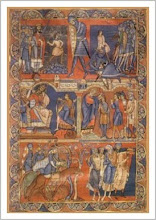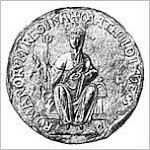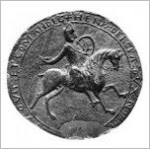In the eleventh and twelfth centuries violent feuds between the various Welsh princes often spilled into the Welsh Marches, an area along the border between England and Wales. Military campaigns into Welsh territory were also waged by the Marcher lords and the Anglo-Norman kings. Indeed, William the Conqueror exacted a tribute and fealty from the rebellious Rhys ap Tewdwr in 1081, William Rufus invaded twice in 1097, and Henry I successfully subdued the Welsh in 1114 and 1121.
What of King Stephen?
By and large it can be safely said that Stephen had his hands full dealing with the civil war and his unruly barons for most of his nineteen year reign. In 1146 Ranulf, Earl of Chester suggested a Welsh campaign to Stephen but his advisors were opposed to such a move and any plans that he may have been considering were called off at their insistence. That is not to say however that military matters in Wales were in a state of complete suspension during the years 1135-54.
Owain ap Gruffydd was one Welsh prince who seized the opportunity to take advantage of the disputes in England between King Stephen, David of Scotland, his barons, and the eventual civil war with the forces of the Empress Matilda. It is thought that Owain was born in approximately 1095 on Anglesey. He and his brothers Cadwallon and Cadwaladr successfully led the forces of Gwynedd against the Normans. Although the elder brother, Cadwallon, was killed in battle against the forces of Powys in 1132, Owain and Cadwaladr, in alliance with Gruffydd ap Rhys of Deheubarth, won a major victory over the Normans at Crug Mawr near Ceredigion in 1136. The castle of Mold was captured in 1146 and Rhuddlan in about 1150.
In a nutshell? Although Normans who held baronial lands in Wales certainly did fight staunchly to hang on to them, and Stephen did besiege several castles within the vicinity of the Marches during his battles against his enemies forces, it appears that Stephen himself played no active part in any campaigns to further English interests in Wales. It was basically left to his successor, Henry II, to (rightly or wrongly) reassert English control in his Welsh campaigns of 1157, 1163, and 1165.
The Story of Gwenllian ferch Gruffydd
Gwenllian ferch Gruffydd is best known for her patriotic revolt and death in a battle near Kidwelly Castle in 1136. She was the daughter of Gruffydd ap Cynan, Prince of Gwynedd and Angharad ferch Owain. The youngest of eight children, she was born in 1097 at Anglesey. In 1113 Gruffydd ap Rhys, the Prince of Deheubarth, visited her father and the result of this meeting had an unforeseen outcome - Gwenllian and Rhys eloped. However the story isn't as romantic as it first sounds. Deheubarth was struggling against the Norman invasion of south Wales, and although she joined her husband at his family seat Dinefwr, they were often absent leading retaliatory strikes against Norman held positions, which included harassing the population settlements of the invaders and taking hold of their wealth and possessions which was then handed back to the dispossessed Welsh.
In 1136 Hywel ap Maredudd, Lord of Brycheiniog, seized on the distractions in England, gathered his army, and defeated the Norman forces in the Battle of Llwchwr. Apparently inspired by Hywel's success, Gruffydd ap Rhys journeyed to Gwynedd to meet with Gwenllian's father in the hope of forging an alliance with Gruffudd ap Cynan against the Normans. It was during his absence that Maurice of London led Norman raids against Deheubarth which compelled Gwenllian to raise an army for its defence.
The battle was fought in a field near Kidwelly Castle in Gwent, and by its end Gwenllian's army had been routed. One of her sons, Morgan, was slain and another, Maelgwyn, captured and executed. Her own fate was to be captured and beheaded - a heroic but tragic end to the romance that began her marriage to Rhys. Gwenllian's death wasn’t to be the end of it however. Her brothers Owain and Cadwaladr invaded Ceredigion and took Llanfihangel, Aberystwyth, and Llanbadarn. Iowerth ab Owain of Gwent ambushed and killed Richard Fitz Gilbert de Clare, the Norman lord who controlled Ceredigion. By late September 1136 the combined forces of Gwynedd, Deheubarth, and Powys had gathered in Ceredigion, and in the Battle of Crug Mawr inflicted a resounding defeat on the Norman army.
In the field near Kidwelly, known as Maes Gwenllian (Field of Gwenllian), a spring which is said to have welled up on the spot where she was beheaded is named after her.
Her defence of Deheubarth is the only known record of a woman from the medieval period leading a Welsh army into battle.
Reference points for further reading:
The Aberffraw Resistance
The Norman Invasion of Wales
Welsh Marches
The Marcher Lords
History of Kidwelly Castle
13 January 2011
Subscribe to:
Comments (Atom)







